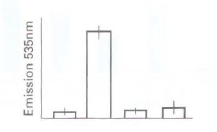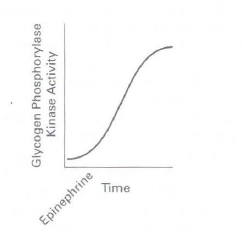The phosphorylation of a protein can influence its ability to interact with other proteins. These protein-protein interactions
Question:
a. You are using fluorescence energy transfer to investigate PKA interactions with glycogen phosphorylase kinase and have cloned eDNA fusion constructs for three of its four different subunits (γ, β, and δ), all containing a fluorescent tag that when expressed excites at 480 nm and emits fluorescence at 535 nm. You also have eDNA encoding the catalytic domain of PKA fused to a tag that when expressed excites at 440 nm and emits at 480 nm. ln the assay, if the PKA fusion protein interacts with one or more of the ragged glycogen phosphorylase kinase substrates, the transfer of energy from the PKA tag excites the tag on the substrate, causing it to emit fluorescence at 535 nm, and this can be detected. Liver cells are transfected with the PKA fusion construct alone (control) or with the PKA fusion construct plus one of the three tagged glycogen phosphorylasc kinase constructs and then later treated with epinephrine. The fluorescence emissions at 535 nm, resulting from the four different transfection experiments, repeated three different times, are shown in the graph below. Label the four bars on the graph, showing the emission of PKA by itself, PKA + the γ subunit, PKA + the β subunit, and PKA + the δ subunit. Explain why there is only one major peak and why the values represented by the other three bars are not significantly different from each other.

b. Which combination above would produce emission at 535 nm if the experiment was repeated but instead of epinephrine you used dibutyryl-cAMP, which freely crosses the plasma membrane?
c. As described above, there are two regulatory subunits of glycogen phosphorylase kinase, both of which are subjected to post-translational modifications. If the gene encoding the a. subunit contained missense mutations whereby during translation all the serine, threonine and tyrosine residues were converted to some other amino acid, how would this affect the calcium sensor subunit of glycogen phosphorylase kinase? The activity of glycogen phosphorylase kinase in cells treated with epinephrine is shown in the following graph.

Draw what the activity would look like in comparison in epinephrine-treated cells expressing the α subunit containing the missense mutations described above.
Step by Step Answer:

Molecular Cell Biology
ISBN: 978-1429234139
7th edition
Authors: Harvey Lodish, Arnold Berk, Chris A. Kaiser, Monty Krieger, Anthony Bretscher, Hidde Ploegh, Angelika Amon, Matthew P. Scott





